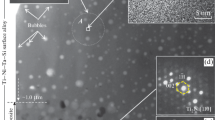Abstract
The stability of C54 Ti(Si1−yGey)2 films in contact with Si1−xGex substrates was investigated. The titanium germanosilicide films were formed from the Ti − Si1−xGex solid phase metallization reaction. It was observed that Ti(Si1−yGey)2 initially forms with the same germanium content as the Si1−xGex substrate (i.e., y = x). Following the initial formation of TiM2 (M = Si1−yGey), silicon and germanium from the substrate diffuse into the TiM2 layer, the composition of the TiM2changes, and Si1−zGez precipitates form along the TiM2 grain boundaries. The germanium content of the Ti(Si1−yGey)2 decreases, and the Si1−zGez precipitates are germanium rich such that y < x < z. This instability of the TiM2 film and the dynamics of the germanium segregation were examined using the Ti-Si-Ge ternary equilibrium diagram. The relevant region of the ternary diagram is the two phase domain limited by a Si-Ge solid solution and a TiSi2–TiGe2 solid solution. In this study first approximation Ti(Si1−yGey)2 -to- Si1−xGex tie lines were calculated on the basis of classical thermodynamics. The tie line calculations indicate that for C54 Ti(Si1−yGey)2 to be stable in contact with Si1−xGex, the compositions of the two phases in equilibrium must be such that y < x. The specific compositions of the two phases in equilibrium depend on the temperature and the relative quantities of the two phases. The dynamic processes by which the Ti(Si1−yGey)2/Si1−xGexsystem progresses from the as-formed state (y = x) to the equilibrium state (y < x) can be predicted using the tie line calculations.
Similar content being viewed by others
References
O. Thomas, F. M. d’Heurle, and S. Delage, J. Mater. Res. 5, 1453–1461 (1990).
N. Boutarek and R. Madar, Appl. Surf. Sci. 73, 209–213 (1993).
D. B. Aldrich, R. J. Nemanich, and D. E. Sayers, in Proceedings of the 7th International Conference on X-ray Absorption Fine Structure; Vol. 32, Suppl. 32-2, edited by H. Kuroda, T. Ohta, T. Murata, Y. Udagawa, and M. Nomura (Japanese Journal of Applied Physics, Tokyo, Japan, 1993), p. 725–727.
D. B. Aldrich, Y. L. Chen, D. E. Sayers, R. J. Nemanich, S. P. Ashburn, and M. C. Özturk, J. Appl. Phys. 77, 5107–5115 (1995).
D. B. Aldrich, R. J. Nemanich, and D. E. Sayers, J. Mater. Res. 10, (1995).
F. M. d’Heurle and J. Gupta, Appl. Surf. Sci. 73, 214–224 (1993).
Cohesion in metals: transition metal alloys; Vol., edited by F. R. deBoer, R. Boom, W. C. M. Mattens, A. R. Miedema, and A. K. Niessen (North-Holland Physics Publishing, New York, NY, 1988).
P. Gordon, Principles of phase diagrams in materials systems (Krieger, Malabar, FL, 1983).
Acknowledgments
The authors gratefully acknowledge the assistance of J. Montgomery. This work was supported in part by the National Science Foundation through grant DMR-9204285 and the Department of Energy through contract DE-FG05-89ER45384.
Author information
Authors and Affiliations
Rights and permissions
About this article
Cite this article
Aldrich, D.B., D’Heurle, F.M., Sayers, D.E. et al. Interface Stability of Ti(Si1−yGey)2 and Si1−xGeX Alloys. MRS Online Proceedings Library 402, 21–26 (1995). https://doi.org/10.1557/PROC-402-21
Published:
Issue Date:
DOI: https://doi.org/10.1557/PROC-402-21




